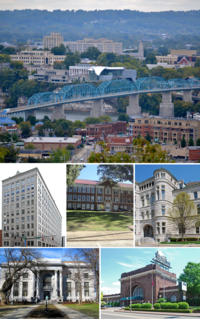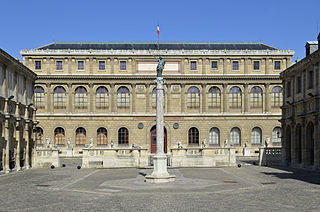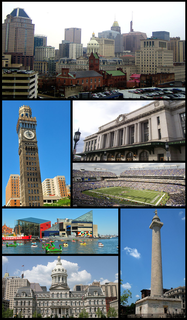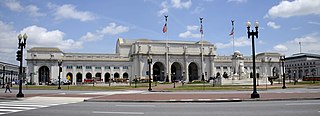
Washington Union Station is a major train station, transportation hub, and leisure destination in Washington, D.C. Opened in 1907, it is Amtrak's headquarters and the railroad's second-busiest station with annual ridership of just under 5 million and the ninth-busiest in overall passengers served in the United States. The station is the southern terminus of the Northeast Corridor, an electrified rail line extending north through major cities including Baltimore, Philadelphia, New York City, and Boston and the busiest passenger rail line in the nation.

Tower City Center, originally known as Cleveland Union Terminal, is a large mixed-use facility located on Public Square in downtown Cleveland, Ohio. The facility is composed of a number of interconnected office buildings, including the landmark Terminal Tower, the Avenue shopping mall, a casino, two hotels, and the main hub of Cleveland's four rapid transit lines. On March 17, 1976, the tower was added to the National Register of Historic Places as the Union Terminal Group.

Dearborn Station was the oldest of the six intercity train stations serving downtown Chicago, Illinois. It currently serves as office retail and entertainment space. Located at Dearborn and Polk Streets, adjacent to Printers Row, the station was owned by the Chicago & Western Indiana Railroad, which itself was owned by the companies operating over its line. The station now houses a shopping mall.

Pennsylvania Station is an intermodal passenger station in Newark, New Jersey. Located at Raymond Plaza, between Market Street and Raymond Boulevard, Newark Penn Station is served by multiple rail and bus carriers, making it the fourth-busiest transportation hub in the New York metropolitan area. It is served by the Newark Light Rail, three NJ Transit commuter rail lines, the PATH rapid transit system, and all 11 of Amtrak's Northeast Corridor services. The station is also served by intercity bus carriers Greyhound, Peter Pan, and Trailways, as well as 33 local and regional bus lines operated by NJ Transit Bus Operations and ONE Bus (Orange-Newark-Elizabeth).
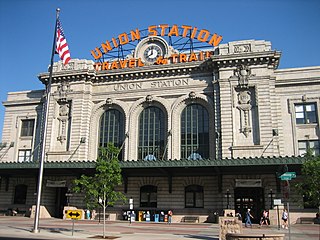
Denver Union Station is the main railway station and central transportation hub in Denver, Colorado. It is located at 17th and Wynkoop Streets in the present-day LoDo district and includes the historic terminal building, a train shed, a 22-gate underground bus facility, and light rail station. A station opened on the site June 1, 1881, burning in 1894. The current structure was erected in two stages, with an enlarged central portion completed in 1914.
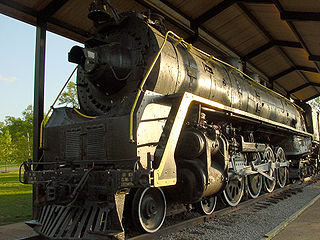
The Nashville, Chattanooga and St. Louis Railway was a railway company operating in the southern United States in Kentucky, Tennessee, Alabama and Georgia. It began as the Nashville and Chattanooga Railroad, chartered in Nashville in December 11, 1845, built to 5 ft gauge and was the first railway to operate in the state of Tennessee. By the turn of the twentieth century, the NC&StL grew into one of the most important railway systems in the southern United States.

The Tennessee Valley Railroad Museum is a railroad museum in Chattanooga, Tennessee.
The Cincinnati, New Orleans and Texas Pacific Railway is a railroad that runs from Cincinnati, Ohio, south to Chattanooga, Tennessee, forming part of the Norfolk Southern Railway system.
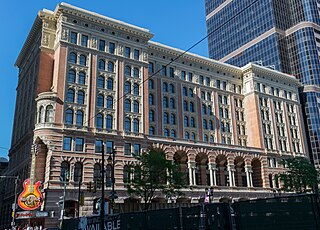
The Reading Terminal is a complex of buildings that includes the former Reading Company main station located in the Market East section of Center City in the city of Philadelphia, Pennsylvania, United States. It is composed of the Reading Terminal Headhouse, Trainshed, and Market.

St. Louis Union Station, a National Historic Landmark, was a passenger intercity train terminal in St. Louis, Missouri. Once the world's largest and busiest train station, it was converted in the early 1980s into a hotel, shopping center, and entertainment complex. Today, an adjacent station serves light-rail passengers on MetroLink's Red and Blue Lines, while the city's intercity train station sits a quarter-mile to the east.
Memphis Union Station was a passenger terminal in Memphis, Tennessee, serving the Missouri Pacific Railroad, St. Louis Southwestern Railway, Louisville and Nashville Railroad, Nashville, Chattanooga and St. Louis Railway and Southern Railway. The terminal, completed in 1912, was built in the Beaux-Arts style and was located on Calhoun Street, between south Second Street and Rayburn Boulevard. It was demolished in 1969. This location in south Memphis was approximately two blocks east of the other major Memphis railroad terminal, Memphis Grand Central Station.

Culver Depot, also called Culver Terminal or Culver Plaza, was a railroad and streetcar terminal in Coney Island, Brooklyn, New York City, United States, located on the northern side of Surf Avenue near West 5th Street. It was just north of the boardwalk, near the former Luna Park amusement complex, and across from the current New York Aquarium. Originally built by the Prospect Park and Coney Island Railroad for the Culver surface line, it later became a major terminal for the Brooklyn Rapid Transit Company (BRT).

The Indianapolis Union Station was the first union station in the world, opening on September 20, 1853, by the Indianapolis Union Railway within the Wholesale District of Indianapolis, Indiana, at 39 Jackson Place. A much larger Richardsonian Romanesque station was designed by Pittsburgh architect Thomas Rodd and constructed at the same location beginning in November 1886 and opening in September 1888. The head house and clock tower of this second station still stand today.

The Birmingham Terminal Station, completed in 1909, was the principal railway station for Birmingham, Alabama until the 1950s. It was demolished in 1969 and its loss still serves as a rallying image for local preservationists.

Little Rock Union Station, also known as Mopac Station, is a train station in Little Rock, Arkansas, United States served by Amtrak, the national railroad passenger system.

The Santa Fe Terminal Complex is an 18-acre (73,000 m2) complex of historic buildings in the Government District of downtown Dallas, Texas (USA). Constructed in 1924 as the headquarters for the Gulf, Colorado and Santa Fe Railway and the Southwest's largest merchandising center, three of the original four buildings remain today and have been renovated into various uses. Santa Fe Buildings No. 1 and No. 2 were listed in the National Register of Historic Places in 1997, and the buildings are Dallas Landmarks. The Santa Fe Freight Terminal is regarded as one of the chief factors in the development of Dallas commercially.

Croton North station is a disused train station on Senasqua Road in Croton-on-Hudson, New York, United States. It was built by the New York Central Railroad in the late 19th century. In 1987 it was listed on the National Register of Historic Places as Croton North Railroad Station.
The Stanton House was a luxurious hotel which existed in the golden era of passenger trains in Chattanooga, Tennessee, United States. It was built in 1871 and named after its founder, John C. Stanton, president of the Alabama and Chattanooga Railroad. The Stanton House was advertised as the "most elegant hotel in the south" at five stories tall with 100 guest rooms. The hotel became a large attraction for wealthy railroad passengers and even hosted president Rutherford B. Hayes. The hotel boasted restaurants, a barber shop, observatory, billiard rooms and a large dining hall which could seat up to 200 guests. The Stanton House was demolished in 1906 for Chattanooga's new terminal station to be built.

